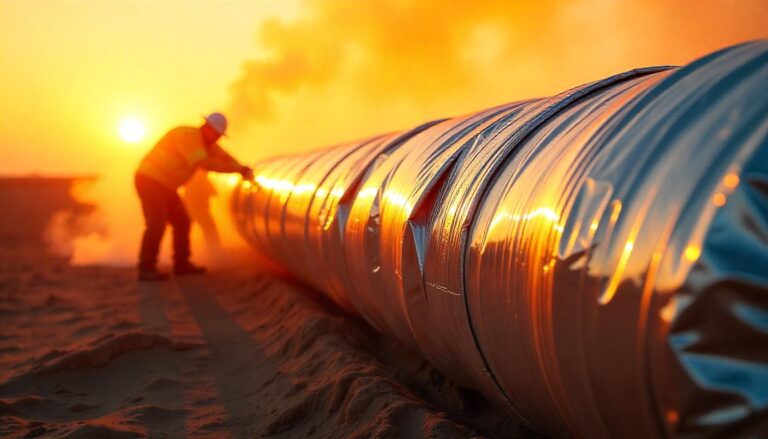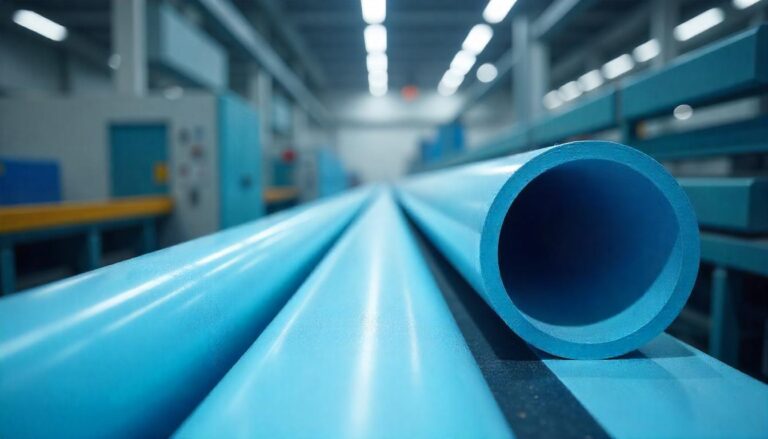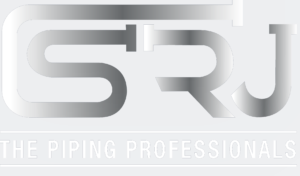How to Successfully Choose and Apply Pipe Coating Methods?
Table of Contents
Pipelines in demanding environments face constant corrosion threats, leading to costly leaks and downtime. Protecting them requires a strategic approach to pipe coating. This guide simplifies the selection, preparation, and application of the optimal coating system, ensuring long-term pipeline integrity and preventing premature failure.
You’ll learn to assess needs, choose methods, understand surface preparation, oversee application, and implement strategies for long-term success.
Step-by-Step Guide to Pipe Coating Methods
Successfully protecting your pipelines from corrosion requires a systematic approach. Follow these steps to navigate the process from initial assessment to long-term maintenance.

Assess the Environment and Service Conditions
The first and most critical step in choosing pipe coating methods is a thorough assessment of the environment in which the pipe will operate and the conditions of the fluid or material it will transport. This assessment dictates the types of stresses the coating will face.
What to do:
- Analyze the external environment: Is the pipe buried underground (soil type, moisture, presence of chemicals or bacteria)? Is it submerged underwater (in freshwater, saltwater, or a specific depth with currents)?
- Evaluate the internal service conditions: What is the temperature and pressure of the fluid? Is it corrosive (acidic, alkaline, presence of dissolved gases like H2S or CO2)? Is it abrasive (slurry, sand)?
- Identify mechanical stresses: Will the pipe be subject to bending, expansion/contraction, soil stress, or external impacts?
- Determine the required service lifespan: How long is the pipeline expected to perform without major maintenance?
Why it matters:
- Different environments cause different types of corrosion (e.g., galvanic corrosion in soil, pitting corrosion in chlorides, stress corrosion cracking).
- Internal conditions can cause internal corrosion or erosion, requiring specific internal pipe coating methods.
- Mechanical stresses can damage brittle coatings, leading to breaches and localized corrosion.
- The desired lifespan influences the required durability and upfront investment in the selected pipe coating methods.
Select the Appropriate Pipe Coating Method(s)
Once you understand the challenges your pipe will face, you can select from the vast array of pipe coating methods available. This is where you match the coating’s properties to your specific environmental and service conditions.
What to do:
Research standard external pipe coating methods:
- Fusion Bonded Epoxy (FBE) Coating: A thermosetting epoxy powder electrostatically applied to heated steel.
- 3-Layer Polyethylene (3LPE) and 3-Layer Polypropylene (3LPP): Multi-layer systems consisting of an FBE primer, a copolymer adhesive, and an outer layer of polyethylene or polypropylene.
- Bitumen Coating: Traditional, cost-effective method offering good water resistance, though less durable mechanically than FBE or polyolefin systems.
- Zinc Coating (Galvanizing): Applying a layer of zinc to steel, typically by hot-dipping for pipes.
- Liquid Epoxy and Polyurethane Coatings: Can be applied in the field or shop. Offer versatility in application thickness and properties (e.g., flexibility, chemical resistance).
- Thermal Spray Coating: Applying molten or heated coating material (often metallic, such as aluminum or zinc alloys) to the surface.
- Glass Flake Coatings: Epoxy or polyester resins loaded with glass flakes. The flakes create a tortuous path for corrosive media, significantly improving barrier properties and abrasion resistance.
- Look at pipe coating trends for 2025: Emerging technologies, such as nanotechnology coatings, self-healing materials, and enhanced inspection techniques, may offer advantages for future projects.
- Evaluate application requirements: Can the coating be applied in the field, or does it require specialized shop application? This impacts logistics and timeline.
Why it matters:
- Each coating method has distinct advantages, disadvantages, and optimal use cases. A bitumen coating, although initially cheap, won’t provide the necessary protection in highly corrosive soils where FBE or 3LPE is required.
- Selecting the wrong coating can lead to premature pipe coating failure, necessitating expensive repairs or replacement long before the pipe’s expected service life has expired.
- Lifecycle costing provides a more accurate picture of the actual cost of protection, preventing choices based solely on upfront price.
- Staying informed about coating innovations can lead to more effective, longer-lasting, or environmentally friendly solutions.
Prepare the Pipe Surface Thoroughly
Surface preparation is the single most critical step in achieving a successful pipe coating application. Even the best coating system will fail prematurely if applied to an inadequately prepared surface.
What to do:
- Remove all contaminants, including grease, oil, dirt, rust, mill scale, old coatings, and any other foreign matter. Use appropriate cleaning methods, such as solvent cleaning, steam cleaning, or power washing, initially.
- Abrasive blast the surface: This is the most common and effective method for creating a clean, roughened surface profile necessary for mechanical adhesion. Select the correct abrasive media (sand, grit, steel shot/grit, garnet) based on the pipe material and desired profile.
- Achieve the specified cleanliness standard: Blast to the required level (e.g., NACE/SSPC SP 5/NACE No. 1 (White Metal), SP 10/NACE No. 2 (Near White Metal), SP 6/NACE No. 3 (Commercial Blast)).
- Create the correct surface profile (anchor pattern): Abrasive blasting creates microscopic peaks and valleys, resulting in a surface profile that is suitable for anchoring.
- Inspect the prepared surface: Immediately after blasting, inspect the surface for cleanliness and profile.
Why it matters:
- Proper surface preparation is the foundation for coating adhesion. Without good adhesion, the coating can delaminate, allowing corrosive elements to reach the pipe surface and lead to pipe coating failure.
- Contaminants left on the surface (especially salts or oils) can cause osmotic blistering or interfere with curing, compromising the coating’s integrity.
- The correct surface profile ensures mechanical interlocking between the coating and the steel, enhancing its ability to withstand operational stresses and preventing cathodic disbondment.
Apply the Chosen Coating System
With the surface perfectly prepared, it’s time to apply the coating. Precision and adherence to the manufacturer’s specifications are paramount in this step.
What to do:
- Follow manufacturer guidelines strictly: Every coating product has specific instructions regarding mixing ratios, induction times, pot life, application temperature range, required film thickness, and curing procedures.
- Control environmental conditions: Monitor and control ambient temperature, surface temperature, and relative humidity.
- Apply primers and intermediate coats (if part of the system): For multi-layer systems, such as 3LPE/3LPP, apply the FBE primer layer correctly, followed by the adhesive and topcoat layers within the specified time windows (intercoat window).
- Ensure correct film thickness: Apply the coating to the specified dry film thickness (DFT) as specified. Applying too thin a coat provides inadequate barrier protection.
- For FBE coating: Electrostatic spray of powder onto a preheated pipe.
- For 3LPE/3LPP: Side extrusion or crosshead extrusion of the polyolefin layer onto the FBE/adhesive layers.
- For Liquid Coatings (epoxies, polyurethanes, glass flake): Airless spray, conventional spray, brush, or roller, depending on the product and area.
- For thermal spray, the arc spray or flame spray process involves applying molten metal wires or heated powder to the surface.
- Allow for proper curing: Follow the manufacturer’s specified curing schedule, which depends on temperature and humidity.
Why it matters:
- Correct application ensures the coating forms a continuous, uniform barrier with the intended physical and chemical properties.
- Proper curing is essential for the coating to achieve its full hardness, chemical resistance, and adhesion strength. An under-cured or improperly cured coating will not perform as expected.
- Controlling environmental conditions prevents common defects, such as blistering, pinholing, or poor cure.
Inspect and Test the Applied Coating
Once the coating is applied and cured, a thorough inspection and testing regime is crucial to verify its quality and integrity before the pipe goes into service. This is a vital component in preventing pipe coating failure.
What to do:
- Conduct visual inspection: Examine the entire coated surface for visible defects such as holidays (pinholes or skips), runs, sags, bare spots, blisters, cracks, craters, or embedded contaminants.
- Measure Dry Film Thickness (DFT): Use calibrated gauges (magnetic induction for steel) to verify that the coating thickness meets the specification.
- Perform Holiday Testing (Spark Testing): Use a low-voltage wet sponge tester for thin film coatings or a high-voltage pulse tester for thicker coatings (like FBE or multi-layer systems).
- Conduct Adhesion Testing: Perform destructive adhesion tests (e.g., pull-off test using a dolly and an adhesion tester, or a knife adhesion test) on representative sections or test panels to ensure the coating is adequately bonded to the substrate.
- Perform Cathodic Disbondment Testing: This is typically a laboratory test conducted on coated samples, although field tests may also be performed. It evaluates how well the coating resists delamination when subjected to cathodic protection potentials, simulating conditions on a buried pipeline.
- Document everything: Keep detailed records of all inspections and tests, including dates, locations, results, equipment used, and personnel involved.
Why it matters:
- Inspection and testing are your final checks to ensure the coating will perform as intended in service.
- Detecting defects like holidays is critical; even a tiny pinhole can lead to localized corrosion and catastrophic pipe coating failure over time, especially on buried pipelines where cathodic protection current can concentrate at defects (cathodic disbondment).
- Verifying DFT, adhesion, and cathodic disbondment resistance confirms that the coating was applied correctly and meets the required performance standards.
Implement Post-Coating Handling and Storage
Even after a perfect application and successful inspection, the coating can still be damaged before installation if not handled and stored correctly. Preventing mechanical damage during this phase is crucial to avoiding long-term pipe coating failure.
What to do:
- Use proper lifting and handling equipment: Never use hooks or chains directly on the coated surface. Use wide fabric slings or specialized pipe lifting equipment designed to protect the coating.
- Stack pipes correctly: Use non-abrasive dunnage (supports) between layers of pipes. Ensure the dunnage is wide enough and properly spaced to prevent the pipes from rolling or the coating from being crushed.
- Protect from mechanical impact: Be mindful of surrounding activities on the job site that could cause impact damage (e.g., heavy machinery traffic, falling objects).
- Protect from environmental exposure during storage: If stored outdoors for extended periods, protect the coated pipes from direct sunlight (UV radiation, especially for certain coating types like polyethylene), excessive heat or cold, and standing water.
- Handle coated field joints carefully: The coating applied to field joints (applied after pipes are welded together) is often less robust than the main line coating.
Why it matters:
- Damage to the coating during handling or storage creates breaches in the protective barrier. These damaged areas are highly susceptible to corrosion once the pipe is in service.
- Even seemingly minor scratches can lead to significant issues over time, especially in corrosive environments or on cathodically protected pipelines where damage points become anodes.
- Improper storage can expose the coating to harmful UV radiation or excessive temperatures, degrading its physical properties before it is installed.
Plan for Maintenance and Monitoring
Pipe coatings are designed for long-term protection, but they are not maintenance-free. Implementing a plan for ongoing monitoring and maintenance is essential to detect potential issues early and maximize the lifespan of the pipe coating methods you’ve implemented.
What to do:
- Establish a regular inspection schedule: Periodically inspect exposed sections of the pipeline (if any) for signs of coating degradation, damage, or peeling.
- Integrate with cathodic protection monitoring: If the pipeline uses cathodic protection (which is common for buried/submerged coated pipelines), monitor the CP system’s performance (potential readings, current output).
- Monitor for signs of coating failure: Be vigilant for visual cues, such as blistering, cracking, peeling, or rust staining, on exposed areas.
- Plan for localized repairs: Have procedures and approved materials in place for repairing small areas of damaged coating in the field.
- Consider environmental factors: Be aware of changes in the surrounding environment that could impact the pipeline and its coating.
Why it matters:
- All coatings have a finite lifespan, influenced by environmental severity and operational stresses.
- Early detection of coating damage or degradation enables proactive intervention through localized repairs, thereby preventing the need for more expensive and disruptive full recoating or pipe replacement later.
- Combining coating monitoring with cathodic protection monitoring provides a comprehensive picture of the pipeline’s integrity and the effectiveness of your corrosion prevention strategy.
- Addressing coating failure prevention proactively extends the overall service life of the pipeline, resulting in significant cost savings and enhanced safety.

Conclusion
Protecting your pipelines from corrosion is a significant undertaking. However, by following this step-by-step guide and paying attention to the details, you can confidently choose and apply the proper pipe coating methods tailored to your specific needs.
Implementing these strategies ensures the longevity, safety, and reliability of your critical infrastructure, saving you time, money, and worry in the long run. Begin your initial assessment today and secure your facility’s future.
Need expert assistance? Contact us now.
In summary, selecting the right corrosion protection coating is critical for extending pipeline lifespan, minimizing environmental risks, and reducing maintenance costs across industrial sectors. From robust 3LPE coatings for underground harsh environments to FBE coatings offering superior adhesion and chemical resistance, each method balances cost, durability, and application-specific demands. For further insights, explore our deep dives on corrosion protection fundamentals and piping quality control best practices. Industry leaders like Polyguard and Lined Pipe Systems also provide valuable technical guidance on coating selection and application protocols.
Key Links to read:
Key Resources:
Need Help Choosing the Right Pipe Coating Method?
Our experts at SRJ Piping India guide you in selecting the most effective, corrosion-resistant coating systems based on your pipeline’s environment, fluid type, and service conditions.
